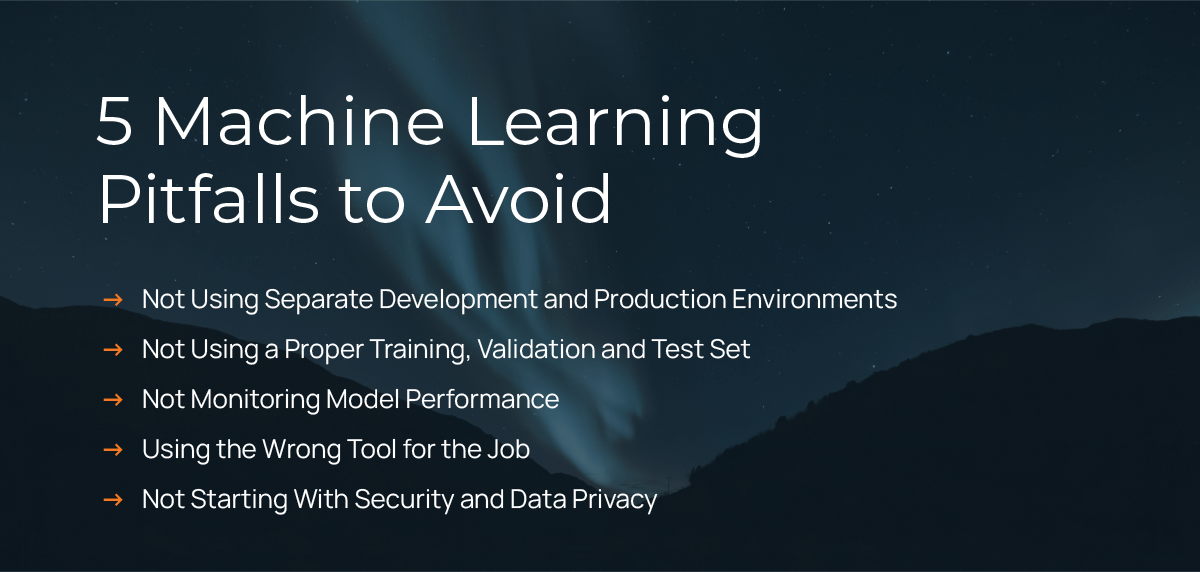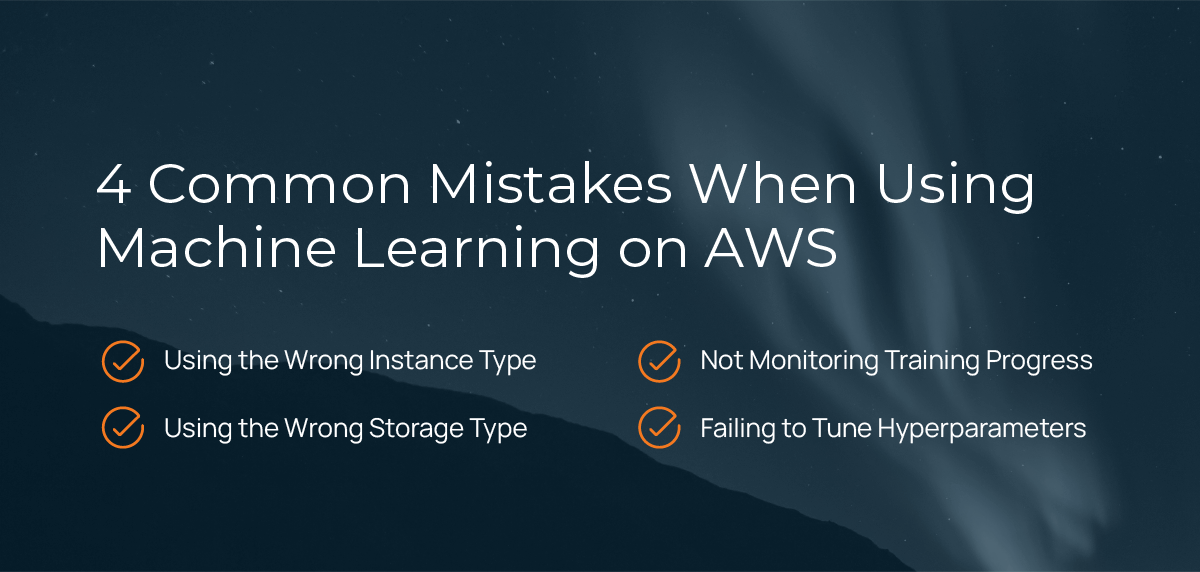Blog
Pitfalls to Avoid With Machine Learning and AWS
Amazon Web Services (AWS) and its massive list of offerings make it easier than ever to build and deploy machine learning models. And while the possibilities are nearly limitless, you can easily go wrong with machine learning and AWS if you don’t know what you’re doing.
If you’re new to AWS or machine learning (ML), you want to avoid rookie mistakes. But even the most experienced experts can run into problems. Learn more about common ML mistakes and how to avoid them.
Machine Learning Pitfalls to Avoid
Artificial intelligence (AI) and ML technologies have revolutionized the way we approach data analysis, but they aren’t without challenges. Here are common mistakes many people make when working with ML models.
Not Using Separate Development and Production Environments
Development and production environments should be separated because they have different aims and risk tolerances. You never want your development environment to interfere with or override the production environment, just as you don’t want to be limited by the confines of the production environment. Using a single environment can lead to unfinalized changes going live, which creates errors, unexpected results and reputational risk.
Creating purpose-built environments allows for easier debugging and testing, letting you explore the development environment without affecting production. With a dedicated development environment, it’s easier to test different versions of models and algorithms, and your workflow improves.
Not Using a Proper Training, Validation and Test Set
When your ML work doesn’t employ a proper training, validation, and test set, that means you’re only training the model on a single dataset. This can lead to overfitting, which is when the model is too closely fitted to the training data and can’t generalize to other data.
By using a training set for model training, a validation set for hyperparameter selection and a test set for performance comparison, the model will make more accurate predictions.
As part of these considerations, make sure your data set is large enough to accurately represent the problem. The data set should also be complex enough that the model can identify patterns and make accurate predictions. Also consider the type of data you’re using and how to best train it with your model.
Not Monitoring Model Performance
You can’t know how accurate or effective your ML model is unless you’re tracking performance. Without this knowledge, you’ll generate inaccurate model results and won’t be able to trust in the model or related services.
Data scientists need to monitor performance so they can detect unexpected shifts in the data or any issues with the model that could cause inaccurate predictions. Performance monitoring also helps your team to detect bias or overfitting.
Using the Wrong Tool for the Job
Not every algorithm is right for the model, and not every model is right for the job. Making mistakes here contributes to inaccurate results, wasted time and squandered resources, at best. At worst, the wrong tool can have potentially dangerous consequences.
For example, if a supervised learning algorithm is used for a problem where an unsupervised learning algorithm would be more effective, the accuracy of the results will be lower. If a deep learning algorithm is used to solve a problem where a simpler solution would suffice, unnecessary time and resources are wasted — and you might not realize greater accuracy, either.
Using the wrong tool can have negative real-world consequences. Using the wrong facial recognition algorithm can lead to bias shown against certain individuals or groups. That could be especially dangerous if, for example, you’re using facial-recognition technology to identify or exonerate suspected criminals.
Not Thinking About Security and Data Privacy From the Beginning
Security and data privacy should always be considered when creating and implementing ML models. These models can easily be used for malicious purposes if data isn't secured and privacy isn’t safeguarded.
Data privacy and security must be part of your original plan and is an ongoing responsibility. Belatedly taking protective measures is more difficult and expensive, especially if your data or algorithm has been compromised.

Common Mistakes When Using Machine Learning on AWS
Machine learning on AWS brings its own opportunities and pitfalls. The AWS environment offers a wide range of options, including instance types and storage options. But all those choices can be confusing if you’re not sure what’s right for your ML efforts. Here are some of the most common mistakes users make with AWS.
Using the Wrong Instance Type
There are many instance types available on AWS, and while that offers tremendous flexibility, it also adds complexity. Choosing the wrong instance type usually occurs when you don’t have the proper understanding of different instance types and their specifications. Or you might misestimate the computational requirements of an ML task.
For example, if you underestimate a resource-intensive project, you may choose an instance type that’s too small, resulting in slow model training or even failure. Instance mistakes are commonly about size. If you choose an instance type that's too small, your model won't run properly. If you choose an instance type that's too large, you'll waste resources and money.
Using the Wrong Storage Type
When using ML on AWS, you have to store your data somewhere. There are two main storage types: object storage and relational databases.
Object storage is a method that stores data as objects or files. This is ideal for unstructured data, such as images or videos. Relational databases are a structured method that stores data in tables with defined relationships. This approach is ideal for structured data, such as customer information or financial records. Object storage is cheaper but slower, while relational databases are more expensive but faster.
If you’re new to AWS or ML, you may not be familiar with the different storage types. It’s possible to make mistakes by picking the wrong storage type, but problems also arise from a misunderstanding of data characteristics. For example, using object storage for large datasets that require frequent updates or real-time access can lead to slow performance and high latency.
In addition to poor performance, using incorrect storage types contributes to unnecessary costs. Storing infrequently accessed data in standard storage, for example, can result in higher costs than using infrequent access or glacier storage.
Not Monitoring Training Progress
Much like tracking ML model performance, you need to track progress in AWS environments if you want to know whether your model is improving. If you don’t know where you stand, you could suffer from overfitting or underfitting. Overfitting occurs when the model is too complex and fits the training data too closely, leading to poor generalization and high variance. Underfitting occurs when the model is too simple and can't capture the complexity of the data, leading to high bias and poor performance. Either outcome leads to frustration, not to mention wasted time and resources.
When training an ML model, look for metrics of progress such as accuracy, precision and recall. Validation processes, such as the train test split procedure, allow you to test real-world ML algorithm performance based on a simulation with new or unseen data.
Failing to Tune Hyperparameters
Hyperparameters are variables that control the training process of ML models, and they’re crucial in determining model accuracy and capabilities. Hyperparameters control the learning rate, batch size, branches in a decision tree and many other essential settings.
There are many ways to tune hyperparameters, although doing so can be time-consuming and tedious. A common mistake is when companies fail to invest the time necessary to experiment and to find the best combination of hyperparameters for their particular use cases.
Failing to tune hyperparameters can create significant problems for businesses that rely on ML services. Your models might produce inaccurate or biased predictions that can be difficult to detect or fix.

Benefits of Avoiding Machine Learning Pitfalls
Knowing the most common ML mistakes in general and those often seen with AWS is a valuable first step in improving your ML processes. When you know what to avoid, you can optimize your workflows and approach to do the right things that save time and resources. Here are some benefits of avoiding ML pitfalls.
More Accurate and Reliable Models
When you build ML algorithms and models by following best practices and avoiding obvious mistakes, you’ll get more accurate and reliable results. Your data and outputs will be less likely to suffer from bias, overfitting or other issues that impact performance. This means that you can make better-informed decisions with greater confidence based on ML predictions.
Save Time
Following proper ML procedures might take a little more time upfront, but a major benefit is the time you get back in the long run. Instead of spending time debugging and refining models, you can focus on other areas such as feature engineering, data preprocessing and hyperparameter tuning. Because your models are less likely to suffer from performance issues, they can be deployed faster, which speeds up real-world impact and return on investment.
Optimize Resources
By avoiding common pitfalls such as overfitting and underfitting, you can reduce the computational requirements of your models and lower computing costs. When you’re more confident about the accuracy of your model's predictions, you’ll potentially need less data to train on — saving on the costs of data collection.
Getting Started With Machine Learning and AWS
When you are ready to expand your use of ML and AI services in combination with AWS, your options include Amazon SageMaker Studio, Amazon Rekognition and Amazon Comprehend. The AI services like Comprehend help you to get started quickly and easily, allowing you to deploy ML models without requiring in-depth expertise since they are managed by AWS.
As you get started with machine learning and AWS, be sure your team is educated on the basics and prepared to avoid simple mistakes. When you have a trained staff, a clear understanding of your business needs and goals, the right ML model for your use cases, and a long-term plan for managing data and model performance, you maximize your chances of success.
As you embark on your journey, look for AWS Certified Machine Learning experts such as Mission Cloud. They can provide the knowledge and support you need. If you’re ready to get started, learn how to deploy machine learning in AWS.
Author Spotlight:
Ryan Ries
Keep Up To Date With AWS News
Stay up to date with the latest AWS services, latest architecture, cloud-native solutions and more.
Related Blog Posts
Category:
Category:
Category:

